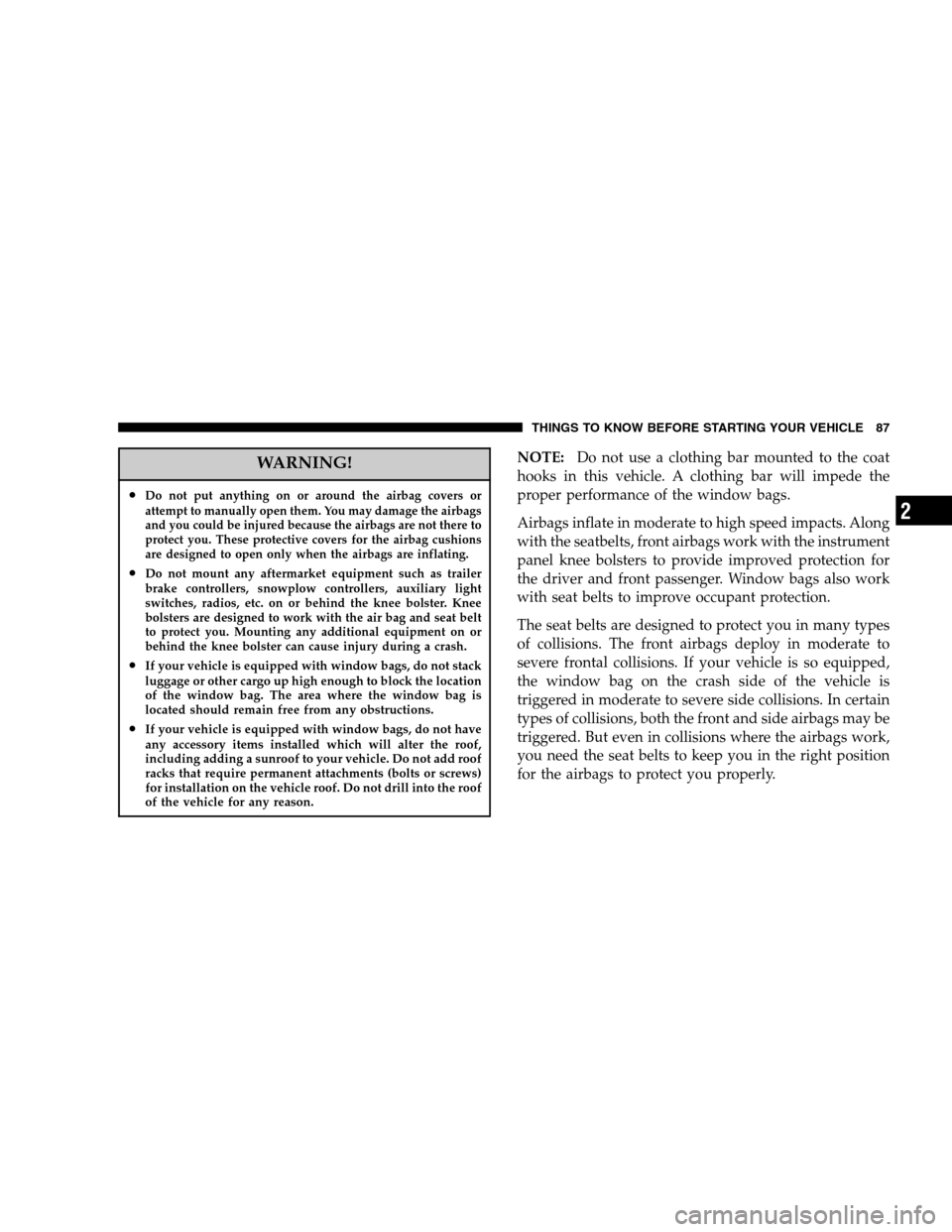Page 87 of 568

WARNING!
•Do not put anything on or around the airbag covers or
attempt to manually open them. You may damage the airbags
and you could be injured because the airbags are not there to
protect you. These protective covers for the airbag cushions
are designed to open only when the airbags are inflating.
•Do not mount any aftermarket equipment such as trailer
brake controllers, snowplow controllers, auxiliary light
switches, radios, etc. on or behind the knee bolster. Knee
bolsters are designed to work with the air bag and seat belt
to protect you. Mounting any additional equipment on or
behind the knee bolster can cause injury during a crash.
•If your vehicle is equipped with window bags, do not stack
luggage or other cargo up high enough to block the location
of the window bag. The area where the window bag is
located should remain free from any obstructions.
•If your vehicle is equipped with window bags, do not have
any accessory items installed which will alter the roof,
including adding a sunroof to your vehicle. Do not add roof
racks that require permanent attachments (bolts or screws)
for installation on the vehicle roof. Do not drill into the roof
of the vehicle for any reason.
NOTE:Do not use a clothing bar mounted to the coat
hooks in this vehicle. A clothing bar will impede the
proper performance of the window bags.
Airbags inflate in moderate to high speed impacts. Along
with the seatbelts, front airbags work with the instrument
panel knee bolsters to provide improved protection for
the driver and front passenger. Window bags also work
with seat belts to improve occupant protection.
The seat belts are designed to protect you in many types
of collisions. The front airbags deploy in moderate to
severe frontal collisions. If your vehicle is so equipped,
the window bag on the crash side of the vehicle is
triggered in moderate to severe side collisions. In certain
types of collisions, both the front and side airbags may be
triggered. But even in collisions where the airbags work,
you need the seat belts to keep you in the right position
for the airbags to protect you properly.
THINGS TO KNOW BEFORE STARTING YOUR VEHICLE 87
2
Page 113 of 568
CAUTION!
•During the first 500 miles (805 km) your new
vehicle is driven, do not tow a trailer. Doing so
may damage your vehicle.
•Limit your speed to 50 mph (80 km/h) during the
first 500 miles (805 km) of towing.
THINGS TO KNOW BEFORE STARTING YOUR VEHICLE 113
2
Page 115 of 568
UNDERSTANDING THE FEATURES OF YOUR VEHICLE
CONTENTS
�Mirrors..............................121
▫Inside Mirror........................121
▫Automatic Dimming Mirror— If Equipped . . . 122
▫Outside Mirrors......................122
▫Exterior Mirrors Folding Feature..........123
▫Electronic Power Mirrors — If Equipped.....123
▫Electric Rear Window Defroster And Heated
Sideview Mirrors — If Equipped..........124
▫Trailer Towing Mirrors — If Equipped......124�Hands–Free Communication (UConnect™) —
If Equipped...........................126
▫Operations..........................127
▫Phone Call Features...................134
▫UConnect™ System Features.............136
▫Advanced Phone Connectivity............141
▫Things You Should Know About Your
UConnect™ System....................142
�Seats................................148
▫40-20-40 Front Seat....................149
3
Page 124 of 568

Set the top switch to the left or right for the left or right
mirror, and set it to the center off position to prevent
accidentally moving a mirror when you are finished
adjusting the mirror. To adjust a mirror, select left or right
with the top switch, and press one of the four arrows for
the direction you want the mirror to move.
Electric Rear Window Defroster and Heated
Sideview Mirrors — If Equipped
The Electric Rear Window Defroster and Heated
side view mirrors are activated by pressing the
heated grid button, located on the Climate Control panel,
with the ignition On. Turning Off the rear window
defroster or the ignition will deactivate the Electric Rear
Window Defroster and Heated side view mirrors feature.
These features also turn off after activation, when 15
minutes have elapsed. To reactivate, simply press the
button again.
Trailer Towing Mirrors — If Equipped
These mirrors are designed with an adjustable mirror
head to provide a greater vision range when towing
extra-wide loads. To change position inboard or out-
board, the mirror head should be rotated (flipped Out or
In). A small blindspot mirror is integrated onto the main
mirror surface.Power Mirror Switches
124 UNDERSTANDING THE FEATURES OF YOUR VEHICLE
Page 125 of 568
NOTE: Fold the7x10inch trailer towing mirrors
rearward prior to entering an automated car wash.
Blindspot Mirror
Trailer Towing Position
UNDERSTANDING THE FEATURES OF YOUR VEHICLE 125
3
Page 229 of 568

NOTE:If the gauge pointer moves to either extreme of
the gauge, the “Check Gages” indicator will illuminate
and a single chime will sound.
10. Transfer Case Position
(See page 316 for more information.)
11 .TOW HAUL
The TOW HAUL button is located at the end of the gear
shift lever. This light will illuminate when the TOW
HAUL OD/OFF button is pushed once. (See page 311 for
more information.)
12.OD/OFF
the OD/OFF button is located at the end of the gear shift
lever. This light will illuminate when the TOW HAUL
OD/OFF button is pushed twice. (See page 311 for more
information.)13. Temperature Gauge
The temperature gauge indicates engine coolant
temperature. Any reading within the normal
range indicates that the cooling system is operat-
ing satisfactorily. The gauge needle will likely indicate a
higher temperature when driving in hot weather, up
mountain grades, in heavy traffic, or when towing a
trailer. If the needle rises to the “245°F” mark, stop the
vehicle, shift into N (Neutral), and increase the engine
idle speed for 2 to 3 minutes. If the temperature reading
does not return to normal, shut your engine OFF and
allow it to cool. Seek authorized service immediately. See
Cooling System information in the section on “Maintain-
ing Your Vehicle.”
UNDERSTANDING YOUR INSTRUMENT PANEL 229
4
Page 235 of 568

TCS Indicator Light” becomes illuminated when the
ESP-Off button has been pressed or ESP is only partially
available.
27. Transmission Oil Temperature Warning Light
(Automatic Transmissions Only)
This light indicates that there is excessive trans-
mission fluid temperature that might occur
with severe usage such as trailer towing. It may
also occur when operating the vehicle in a high
torque converter slip condition, such as 4-wheel-drive
operation (e.g. snow plowing, off- road operation). If this
light comes on, stop the vehicle and run the engine at idle
or faster, with the transmission in NEUTRAL until the
light goes off.
28. Odometer/Trip Odometer Button
Press this button to toggle between the odometer and the
trip odometer display. Holding the button in resets the
trip odometer reading when in trip mode.29. Fuel Gauge
Shows level of fuel in tank when ignition switch is in the
ON position.
30. Low Fuel Warning Light
When the fuel level drops to 1/16 tank, the fuel
symbol will light and a single chime will sound.
(See page 182 for more information.)
NOTE:If your vehicle is equipped with an overhead
console module (CMTC), it is possible for DTE to display
“LO FUEL” before the low fuel warning light turns on in
the instrument cluster. This could occur because the low
fuel warning is set to a specified fuel tank volume and
DTE is an estimated distance calculation based on vehicle
fuel economy and remaining fuel tank volume.
Ram fuel tank volumes are as follows:
•26 gallons - 1500 short box models
•34 gallons - 1500/2500/3500 short box models
•35 gallons - 1500/2500/3500 long box models
UNDERSTANDING YOUR INSTRUMENT PANEL 235
4
Page 294 of 568

Window Fogging
Windows will fog on the inside when the humidity inside
the vehicle is high. This often occurs in mild or cool
temperatures when it’s rainy or humid. In most cases
turning on the Air-conditioning (pressing the snowflake
button) will clear the fog. Adjust the temperature control,
air direction and blower speed to maintain comfort.
As the temperature gets colder it may be necessary to
direct air onto the windshield by using MIX Mode
position on the control. Adjust the temperature control
and blower speed to maintain comfort. Higher blower
speeds will reduce fogging. Interior fogging on the
windshield can be quickly removed by selecting the
defrost mode.
Regular cleaning of the inside of the windows with a
non-filming cleaning solution (vinegar and water works
very well) will help prevent contaminates (cigarettesmoke, perfumes, etc.) from sticking to the windows.
Contaminates increase the rate of window fogging.
Summer Operation
Air conditioned vehicles must be protected with a high
quality antifreeze coolant during summer to provide
proper corrosion protection and to raise the boiling point
of the coolant for protection against overheating. A 50 %
concentration is recommended. Refer to Recommended
Fluids and Genuine Parts for the proper coolant type.
When using the air conditioner in extremely heavy traffic
in hot weather especially when towing a trailer, addi-
tional engine cooling may be required. If this situation is
encountered, operate the transmission in a lower gear to
increase engine RPM, coolant flow and fan speed. When
stopped in heavy traffic, it may be necessary to shift into
NEUTRAL and depress the accelerator slightly for fast
idle operation to increase coolant flow and fan speed.
294 UNDERSTANDING YOUR INSTRUMENT PANEL